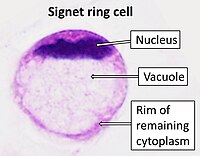
Photo from wikipedia
Objectives: The purpose of this study is to determine the therapeutic value of surgery in individuals with urinary bladder signet ring cell carcinoma (SRCC). Surgery has not been examined as… Click to show full abstract
Objectives: The purpose of this study is to determine the therapeutic value of surgery in individuals with urinary bladder signet ring cell carcinoma (SRCC). Surgery has not been examined as a prognostic factor for urinary bladder cancer (SRCC). Materials and Methods: Using the Surveillance, Epidemiology, and End Results program (SEER), patients with urinary bladder SRCC who presented from 1975 to 2018 were included in a retrospective study. The effect of surgical therapy on cause-specific survival (CSS) and overall survival (OS) was examined using univariate and multivariate Cox regression models. We subdivided 595 patients with SRCC into 2 groups, as follows: 496 who underwent surgery; and 99 who did not undergo surgery. Results: Males had high predominance in all cases in both groups (p = 0.04). Moderate and poor differentiation (III–IV) were observed in the majority of patients who underwent surgery (77.2 vs 58.6, p ⩽ 0.001) and had no insurance (p ⩽ 0.001). By using KM, the OS and CSS of the surgery group were found to be significantly better than those of the non-surgery group (p = 0.001,%) after adjusting for the variables of age, race, sex, primary site, grade, stage, lymph node removal, chemotherapy record, radiotherapy record, insurance, and marital status in the multivariate Cox proportional hazard model (hazard ratio [HR]= 0. 592; 95% confidence interval [CI] = 0.449–0.782; p = 0.0001). In comparison with chemotherapy and radiation, which resulted in poorer survival rates, surgery considerably improved survival outcomes in urinary bladder SRCC. The nomogram prediction model was built with C-index values of 0.70 and 73 for OS and CSS prediction, respectively. AUC in OS values were 0.77, 0.76, and 0.74, whereas AUC in CSS were 0.83, 0.80, and 0.79 for the 1-, 3-, and 5-year survival nomograms, respectively. Conclusion: Surgery was a significant independent predictor of bladder SRCC survival. Patients who underwent surgery had higher CSS and OS than people who did not undergo surgery. Surgery also led to better survival than the combination of the different treatment modalities.
Journal Title: Therapeutic Advances in Urology
Year Published: 2022
Link to full text (if available)
Share on Social Media: Sign Up to like & get
recommendations!